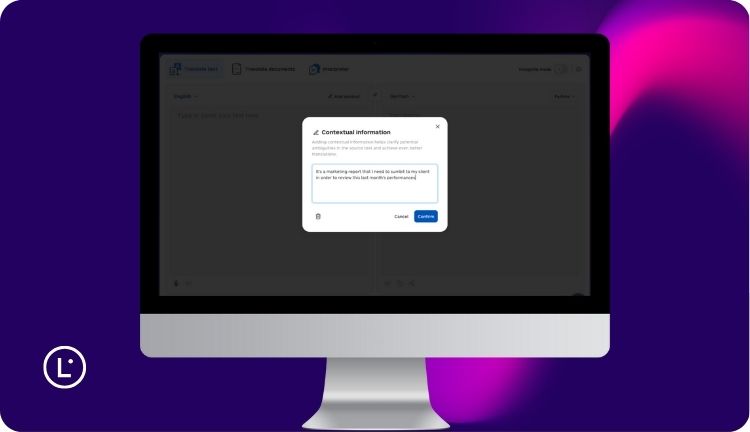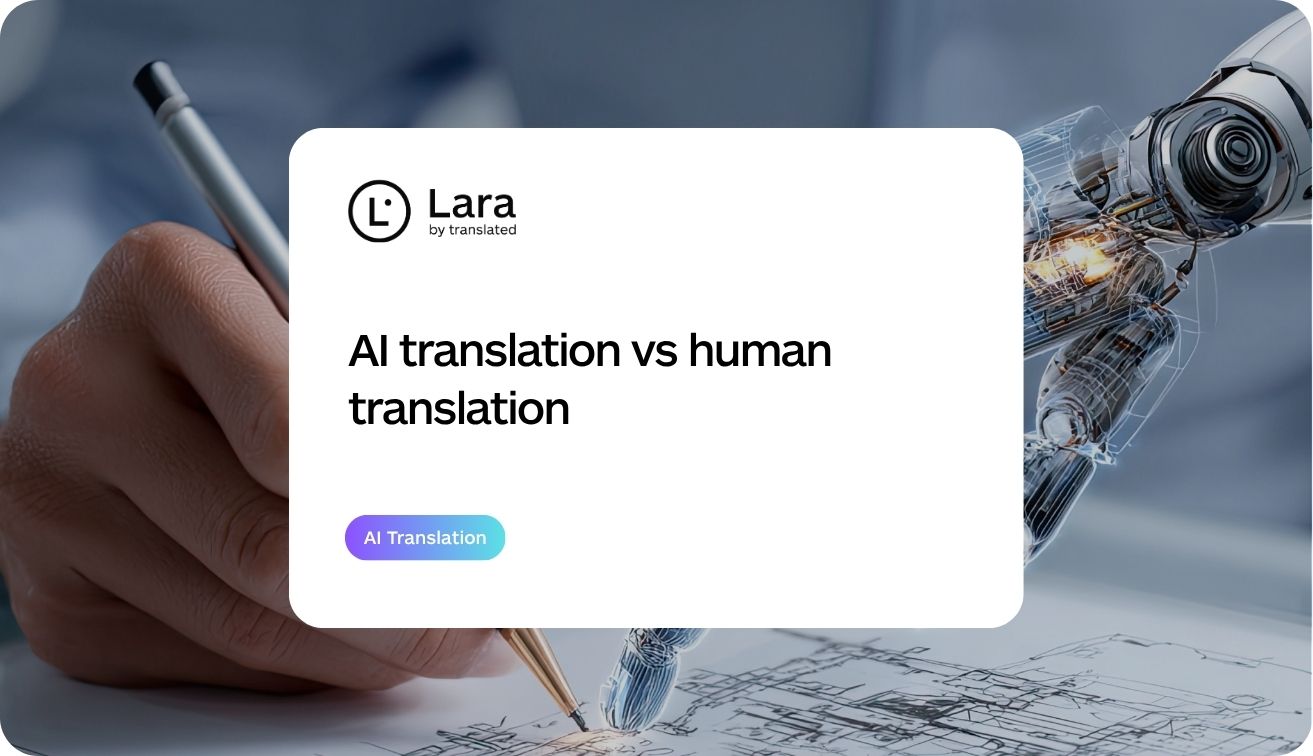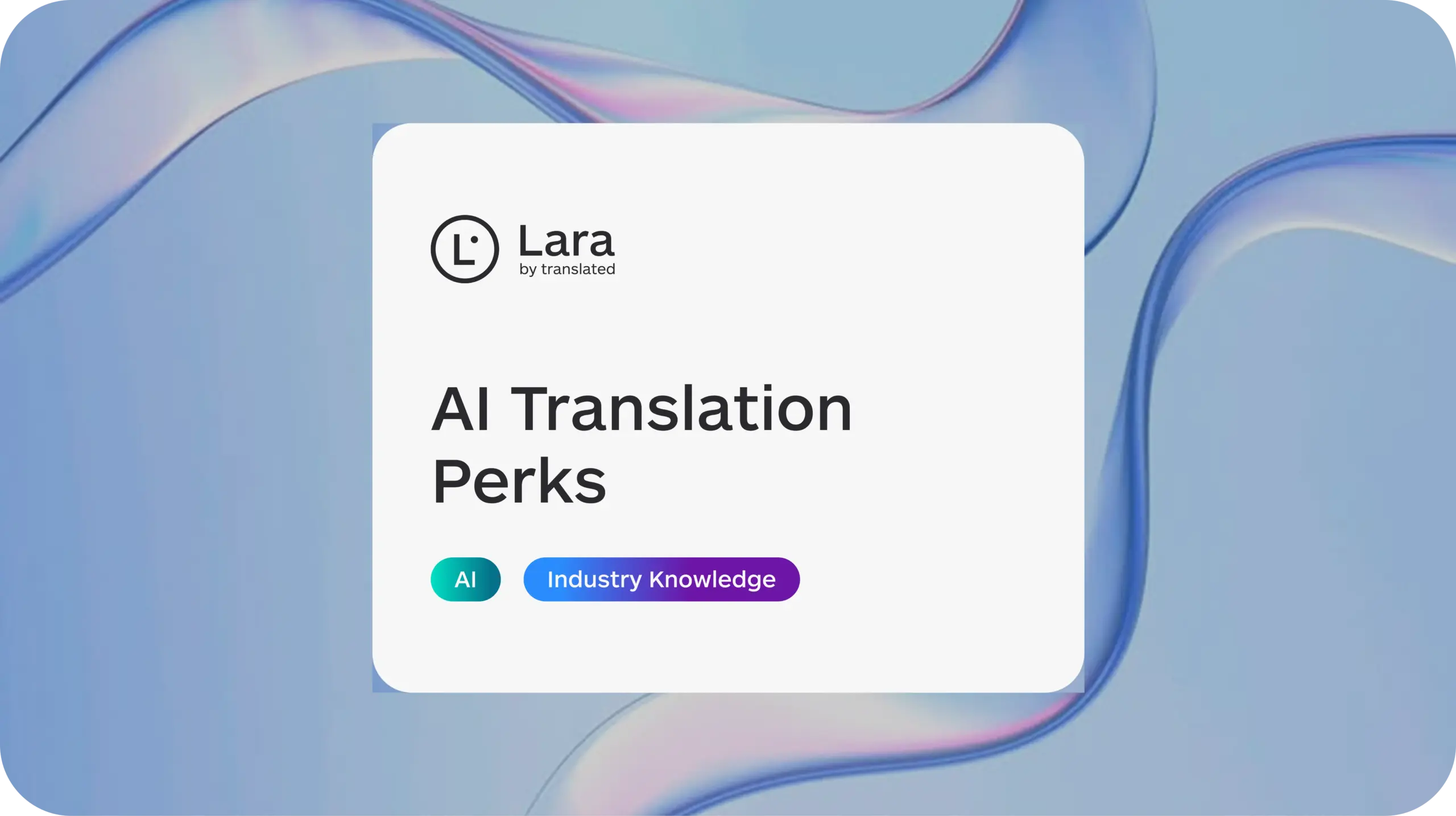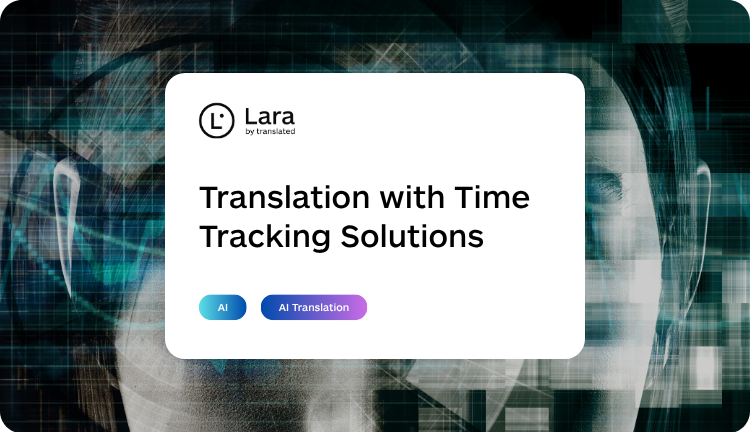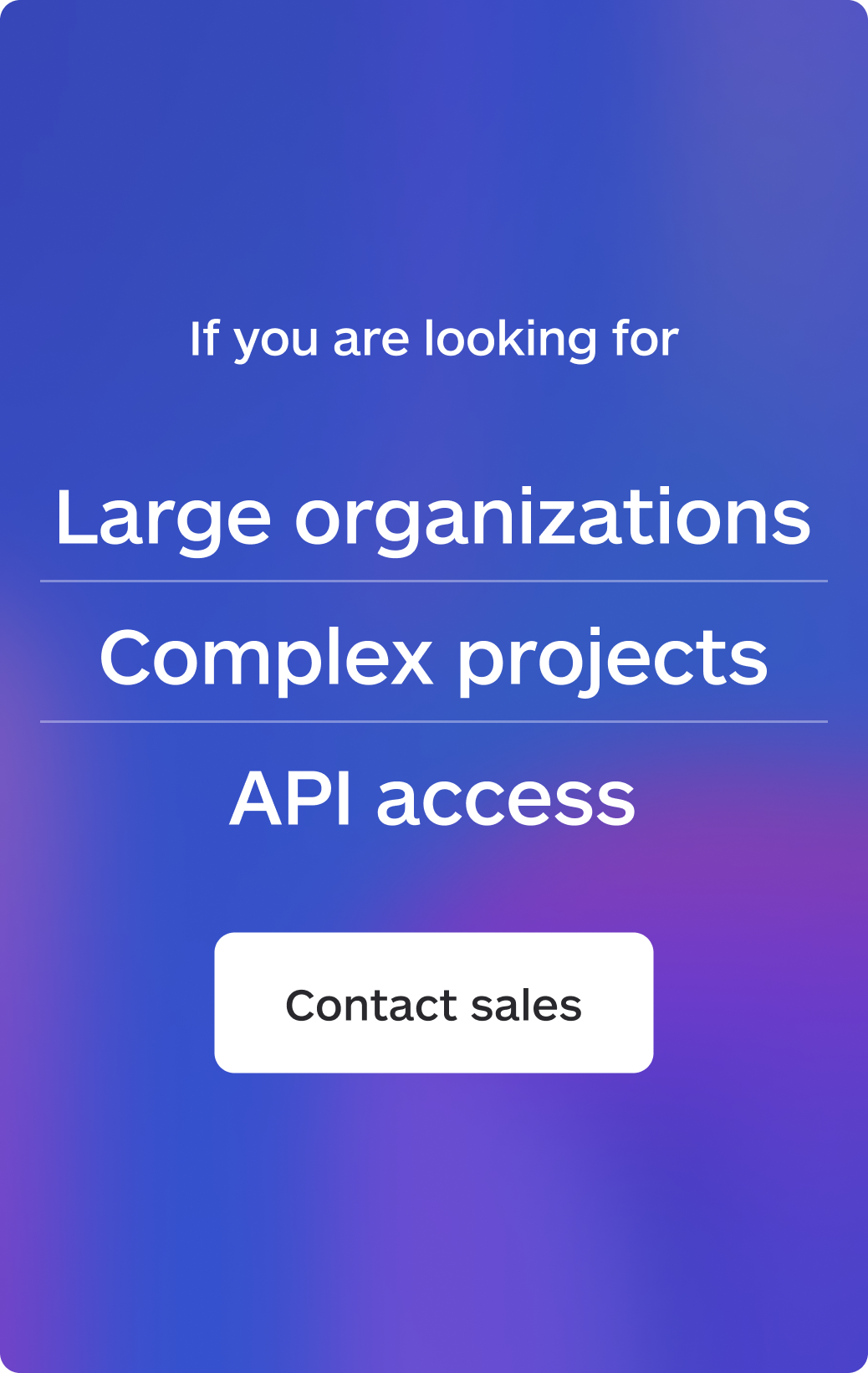Reaching people across languages is one of the biggest steps a business can take to grow and AI translation is making that step faster and more accessible than ever. These tools can help you create multilingual content at scale, but it’s not just about speed. To really get it right, you need to understand how to use AI translation wisely, what common mistakes to avoid, and how to fine-tune the process to get results you can trust.
Understanding AI translation technology
Neural machine translation has transformed automated translation from clumsy, word-for-word substitution to sophisticated systems that understand context and nuance. Modern AI translation tools use complex algorithms and deep learning models to analyze not just individual words, but entire sentences and documents to produce natural-sounding translations.
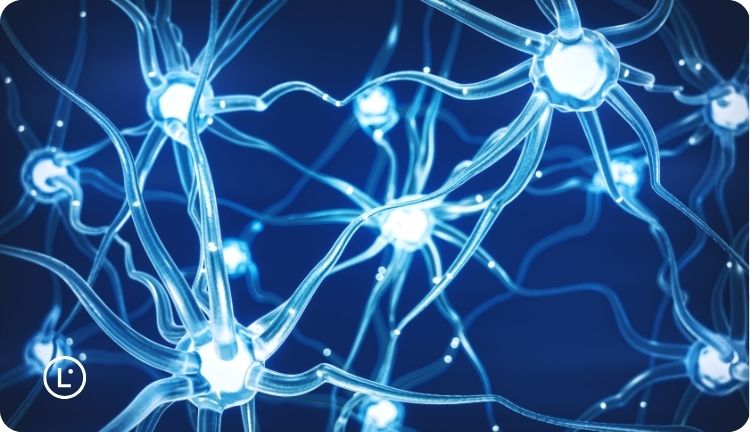
The evolution from rule-based systems to neural networks has dramatically improved quality, though it’s important to recognize that machine translation software still has limitations. While AI excels at handling straightforward content, it may struggle with highly technical, creative, or culturally nuanced material.
Language automation has become an invaluable asset for businesses, content creators, and individuals who need to communicate across language barriers efficiently. However, understanding when and how to use these tools is critical for success.
How to automate translation with AI: setting up your first project
Starting your journey with AI translation doesn’t have to be complicated. Here’s a simple AI translation step-by-step approach to get you started:
- Define your translation needs: Before diving in, clarify what content you’re translating, the target languages, and the intended audience.
- Select appropriate tools: Different AI translation tools excel in different contexts. Research which solution best fits your specific needs, budget, and technical requirements.
- Prepare your content: Ensure your source material is well-structured, free of errors, and uses consistent terminology. Clear, straightforward writing typically produces better translation results.
- Run a test translation: Before committing to a large project, test a small sample to gauge quality and identify potential issues.
- Review and refine: Always review AI-generated translations for accuracy and make necessary adjustments.
This foundational AI translation workflow allows you to start with confidence and gradually expand your use of translation technology as you become more familiar with its capabilities and limitations.
Best practices for AI translation: maximizing quality and efficiency
To achieve optimal results with AI translation tools, consider these essential best practices for AI translation:
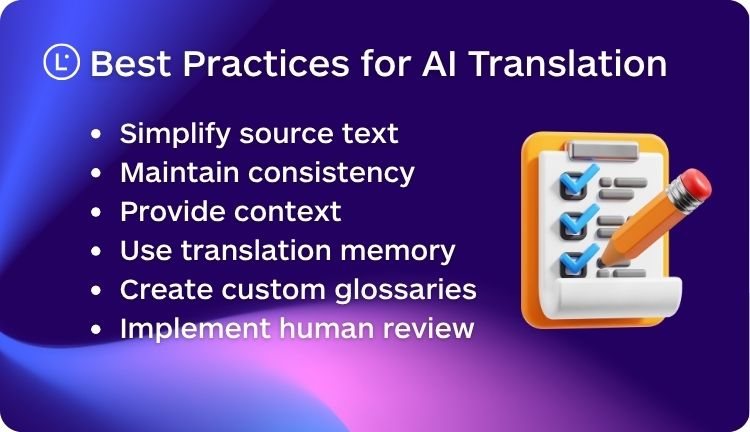
Simplify source text: Write clear, concise sentences with straightforward syntax. Avoid idioms, slang, and overly complex sentence structures that might confuse AI systems.
Maintain consistency: Use consistent terminology throughout your content to help the AI learn and apply your preferred vocabulary accurately.
Provide context: Whenever possible, give the AI translation system adequate context about your content. Some platforms allow you to specify the topic area, which can significantly improve results.
Use translation memory: Implementing translation memory systems alongside AI translation helps maintain consistency across projects and reduces redundant translation work.
Create custom glossaries: Developing glossaries of specialized terms ensures that industry-specific vocabulary is translated correctly and consistently.
Implement human review: While AI can handle the bulk of translation work, human review remains essential for quality assurance, especially for content where accuracy is critical.
By following these guidelines, you’ll significantly improve the quality of your AI-translated content while streamlining your workflow and reducing costs.
Lara Translate: advancing AI translation with precision and context
When considering AI translation tools, Lara Translate stands out with its advanced technology designed specifically for professional translation needs. Unlike general-purpose translation engines, Lara Translate is built on specialized Translation Language Models (T-LMs) trained on high-quality, professionally reviewed content.
Lara’s technology excels particularly in maintaining contextual accuracy across languages, addressing one of the most significant challenges in AI translation. Lara provides exceptional performance for non-English languages often outperforming general Large Language Models in translation tasks.
What truly sets Lara Translate apart is its integration with the Model Context Protocol (MCP), which allows for seamless interoperability between AI systems. This means Lara can work harmoniously with other AI tools in your workflow, enhancing overall productivity and translation quality.
For businesses with regular translation needs, Lara offers significantly faster processing speeds approximately 20 times faster than many competing solutions with most translations completed in just over a second, making it ideal for time-sensitive projects without sacrificing quality.
Common mistakes when using AI translation (and how to avoid them)
Even experienced users can fall into traps when implementing AI translation systems. Here are some common pitfalls and solutions:
- Blindly trusting AI output: Never assume AI translations are perfect. Always review critical content, especially for important documents or customer-facing materials.
- Ignoring cultural context: AI may miss cultural nuances that could lead to inappropriate or offensive translations. Consider cultural sensitivities in your review process.
- Overlooking formatting issues: AI translation can sometimes disrupt formatting, particularly in complex documents. Check formatting carefully after translation.
- Attempting to translate everything: Some content, particularly creative or highly technical material, may still benefit more from human translation or a hybrid approach.
- Not updating terminology databases: As your brand language evolves, ensure your AI translation tools’ glossaries and memory systems are regularly updated.
- Failing to train the AI: Not taking time to train AI for translation through feedback, corrections, and custom datasets limits its potential to improve over time.
By being aware of these potential issues, you can develop strategies to mitigate them and improve your overall translation results.
How to train AI for translation: customizing for your specific needs

Achieving the best possible results often requires training AI for translation to better understand your specific requirements. Here’s how:
- Feed previous translations: Many AI systems allow you to upload past translations to build a custom translation memory that helps the system learn your preferred style and terminology.
- Create custom datasets: For specialized industries, develop training datasets that include technical terms, industry jargon, and preferred translations.
- Implement feedback loops: Systematically collect and incorporate feedback on AI translations to continually improve performance.
- Use domain adaptation: Some advanced systems allow you to specify the content domain (e.g., medical, legal, technical) to improve relevance.
- Apply style guides: Provide style guidelines to ensure translations maintain your brand voice and meet your content standards.
This investment in customization pays dividends through improved accuracy, reduced editing time, and more consistent translations across all your content.
Using machine translation software for different content types
Different content requires different approaches when using AI translation tools. Here’s how to adapt your AI translation workflow for various content types:
- Website content: For websites, consider using translation management systems that integrate with your CMS and preserve HTML formatting. Implement proper SEO considerations for each language version.
- Technical documentation: Technical content benefits from specialized glossaries and domain-specific training. Always have subject matter experts review the final translations.
- Marketing materials: Creative content often requires a more nuanced approach. Use AI for initial drafts but incorporate human creativity and cultural adaptation in the review process.
- Legal documents: For legal content, precision is paramount. Implement rigorous quality control and specialized legal terminology databases alongside AI translation.
- Social media: For quick, informal communications, AI translation can be sufficient with minimal review, but always check for cultural appropriateness.
By tailoring your approach to the specific content type, you’ll achieve better results and more efficient workflows.
When to choose human translation over AI (and when to combine them)
While AI translation tools continue to advance rapidly, human translators still offer distinct advantages in certain scenarios. Understanding when to use each approach is crucial for optimal results.
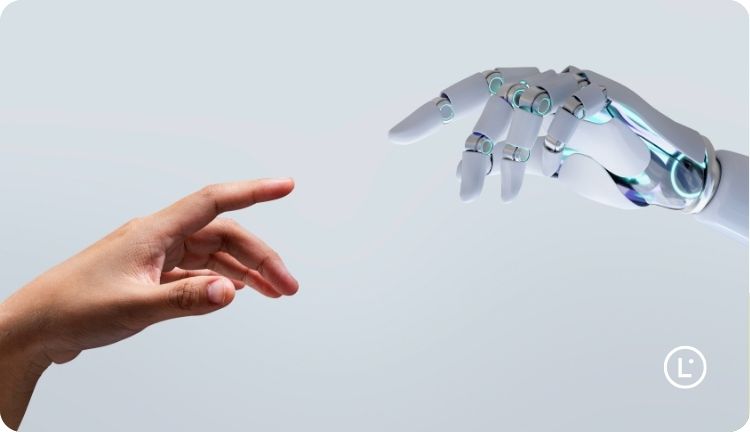
Consider human translation for:
- Creative content requiring emotional resonance
- Highly technical or specialized material
- Legal documents with significant liability implications
- Marketing campaigns that must resonate culturally
- Content with complex wordplay, humor, or cultural references
Consider AI translation for:
- High-volume, repetitive content
- Internal communications where perfect phrasing is less critical
- Time-sensitive materials that need rapid translation
- Content that will undergo human review later
- Preliminary drafts to be refined by human translators
The most effective approach is often a hybrid model that leverages AI integration in translation workflow with human expertise. In this scenario, AI handles the initial translation to save time and reduce costs, while human translators focus on review, refinement, and cultural adaptation.
This collaborative approach maximizes efficiency while maintaining quality standards appropriate to the content’s purpose and importance.
The future of AI translation: what to expect
The landscape of AI translation continues to evolve rapidly, with several trends shaping its future development:
- Improved contextual understanding: Next-generation AI translation systems will better grasp context, reducing ambiguities and improving overall quality.
- Specialized industry models: Expect to see more AI translation tools tailored to specific industries like healthcare, legal, and technical fields.
- Enhanced multimodal capabilities: Future systems will more seamlessly translate across different media formats, including text, audio, video, and images.
- Better preservation of tone and style: Advances in natural language processing will help AI better maintain the author’s original voice across languages.
- Increased integration capabilities: AI translation will become more deeply embedded in content management systems, productivity tools, and communication platforms.
As these advancements continue, the line between human and machine translation will blur further, creating even more powerful tools for global communication.
Implementing an effective AI translation strategy
Effectively using AI translation tools requires understanding both their capabilities and limitations. By following the best practices for AI translation outlined in this guide, you can maximize quality while minimizing costs and turnaround time.
Remember that the most successful approach is often a balanced one that leverages the strengths of both AI and human translators. AI translation systems excel at handling volume, speed, and consistency, while human translators bring nuance, cultural understanding, and creative adaptation.
Start with small projects to familiarize yourself with the technology, gradually refine your AI translation workflow, and continuously evaluate results to improve over time. With thoughtful implementation, AI translation can become a powerful asset in your global communication strategy, helping you reach new markets and connect with audiences worldwide in their native languages.
FAQ
Is AI translation accurate enough for business use?
AI translation has improved dramatically in recent years and is suitable for many business applications. However, the level of accuracy depends on the language pair, content complexity, and the specific AI tool used. For critical business communications, combining AI translation with human review is recommended.
How much does AI translation typically cost?
Costs vary widely based on the provider, volume of content, and features needed. Many services offer tiered pricing models based on usage, with costs ranging from free for basic services to enterprise-level subscriptions for comprehensive solutions.
Can AI translate industry-specific terminology correctly?
Without customization, AI may struggle with specialized terminology. However, many advanced systems allow you to create custom glossaries and train the AI on industry-specific content, significantly improving accuracy for technical terms.
How can I measure the quality of AI translations?
Quality can be assessed through human review, automated quality metrics (like BLEU scores), error rates, and user feedback. For a comprehensive evaluation, consider testing multiple samples across different content types and language pairs.
Will AI translation completely replace human translators?
Despite significant advancements, AI translation is unlikely to completely replace human translators in the foreseeable future. Human translators bring cultural insight, creativity, and judgment that AI currently cannot replicate. The future lies in collaboration between AI and human translators, with each handling the aspects where they excel.
This article is about:
- How to implement AI translation tools and set up an efficient workflow
- Best practices and common pitfalls in AI-powered translation
- When to use machine translation versus human expertise
- How Lara Translate uses advanced AI for business language automation

